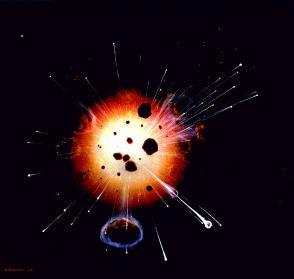The Exploded Planet Hypothesis
'I suspect that there are more things in heaven and earth than are dreamed of, in any philosophy.; -- J.B.S Haldane
See other sub-tabs for articles specific to Cydonia, Mars, or other solar system bodies.
The Exploded Planet Hypothesis (EPH) offers an alternative explanation for the origin of the asteroid belts and comets. For an overview, see Tom Van Flandern's book Dark Matter, Missing Planets & New Comets or read the updated summary posted here, "The Exploded Planet Hypothesis -- 2000". There are presently three known explosion mechanisms.
Far from being a new idea, the EPH fell out of favor with mainstream scientists, primarily for lack of a viable causal theory. However there is a growing body of evidence that suggests planetary explosions may not even be uncommon (see "A Revision of the Exploded Planet Hypothesis"). While most astronomers believe the solar system has remained essentially unchanged since its formation, "The Original Solar System" and "Origin of Trans-Neptunian Asteroids" offer a very different perspective.

Artwork ©1982 Sally J. Bensusen,
http://www.visualsciencestudio.com
Consistent with our mission statement, the EPH makes falsifiable predictions. One way the EPH has distinguished itself from competitive theories is in predicting that many comets and asteroids will have satellites. The satellites of comet Hale-Bopp, discovery of the asteroid Ida's moon Dactyl, and the "Near Challenge Results" are all examples of the success of this genuine prediction.
The EPH was recently used to make exceptionally accurate predictions of the November 1999 Leonids meteor storm, as well as for the two subsequent years. See the complete 2000 and 2001 predictions. This same methodology also predicted another Leonids storm in 2002 as well as a Perseids storm in 2004.
Finally, because the EPH offers a simple explanation for the sudden and dramatic pole shifts on Mars and the crustal dichotomy of the planet, the EPH has been connected with the Cydonia story.
